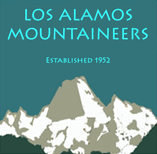|
LAM History Index | Go to Previous Topic | Go to Next Topic For many decades, the Los Alamos Mountaineers have held an annual 5 or 6 week
long climbing school each April and May. This is an ideal way for people
with an interest in mountaineering or climbing to safely acquire some
basic rope handling and climbing skills. It is also a great way for
beginners to meet other club members and for the club itself to acquire
eager new members.
Fig.
1. Two climbers during the April 1967 climbing school, In the late 1960's the climbing school began to transition from the Back Rocks to several of the newly-discovered White Rock climbing areas, primarily Potrillo Cliffs and the "Y." A major exciting and stressful moment for most students is catching "Ludwig," a heavy weight that simulates the shock and pain of catching a leader fall. John Ramsay believes that Gene Tate invented this exercise to train new climbers in how to belay and arrest a falling leader. For about 20 years now, Jim Straight has taken the lead in rigging and running this exercise, with the gratitude of his fellow instructors and the apprehension of his student victims!
Fig.
2. Jim Straight rigs the Ludwig leader fall
Fig.
3. Ruth Kirkpatrick smiles while catching Ludwig during the April 2007 Another stressful
moment in the school is the first rappel from the top of the cliff.
Mario Schillaci recalls that he and Ray Nix were in the 1968 climbing
school, and their instructor, Ernie Anderson, was encouraging all the
students to commit fully to the rappel by really leaning back at the
start. Ray Nix was determined to do this right, and leaned back very
far. Sure enough, he flipped over backwards, and ended up hanging head
down against the cliff! This event happened to a new student every now
and then over the years. But this rappel exercise was always conducted
with a separate belay, so no harm was done.
Fig.
4. Ken Ewing demonstrates ice axe techniques during Graduation climbs for the climbing school used to be held at the Brazos Cliffs or in the Sandias, with 3-person parties doing long ascents of the Shield or the Knife Edge. After a long and tedious climbing experience in the Sandias in 1973, the Mountaineers moved the graduation climb to the El Rito cliff, which the Mountaineers had just learned about from Santa Fe rock climbers. This small climbing area provides excellent 2- and 3-pitch crack and face climbs at a moderate level but with good practice in belay ledges, exposure, and multi-pitch rope handling techniques. LAM History Index | Go to Previous Topic | Go to Next Topic
|
||||||||||||||||||||||||||||




